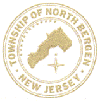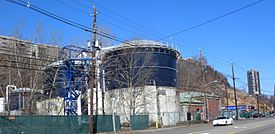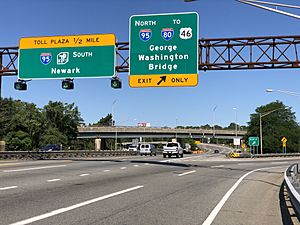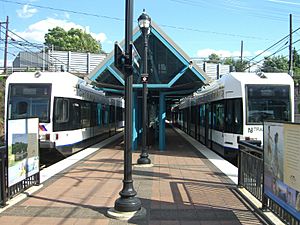North Bergen, New Jersey facts for kids
Quick facts for kids
North Bergen, New Jersey
|
||
|---|---|---|
|
Township
|
||
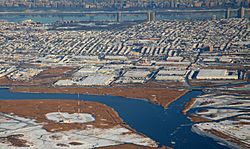
Eastward from Hackensack River in the Meadowlands to Hudson River
|
||
|
||
| Country | ||
| State | ||
| County | ||
| Incorporated | April 10, 1843 | |
| Government | ||
| • Type | Walsh Act | |
| • Body | Board of Commissioners | |
| Area | ||
| • Total | 5.57 sq mi (14.43 km2) | |
| • Land | 5.14 sq mi (13.30 km2) | |
| • Water | 0.44 sq mi (1.13 km2) 7.83% | |
| Area rank | 266th of 565 in state 5th of 12 in county |
|
| Elevation | 112 ft (34 m) | |
| Population
(2020)
|
||
| • Total | 63,361 | |
| • Estimate
(2023)
|
59,394 | |
| • Rank | 23rd of 565 in state 4th of 12 in county |
|
| • Density | 12,336.6/sq mi (4,763.2/km2) | |
| • Density rank | 23rd of 565 in state 9th of 12 in county |
|
| Time zone | UTC−05:00 (Eastern (EST)) | |
| • Summer (DST) | UTC−04:00 (Eastern (EDT)) | |
| ZIP Code |
07047
|
|
| Area code(s) | 201 | |
| FIPS code | 3401752470 | |
| GNIS feature ID | 0882223 | |
North Bergen is a busy township located in the northern part of Hudson County, in the state of New Jersey. It's known for being one of the hilliest towns in the United States, thanks to the Hudson Palisades. It also has a very high population density, meaning many people live close together, similar to other towns in the North Hudson area.
In 2020, about 63,361 people lived here. North Bergen was officially created as a township on April 10, 1843. Over time, parts of its original land were used to form other nearby towns.
Contents
Exploring North Bergen's Past
Early Days and Native Americans
Long ago, before Europeans arrived, the area where North Bergen is now was home to the Hackensack tribe of the Lenape Native Americans. They had a settlement called Espatingh. The Dutch, who were early European settlers, set up a trading post here.
In 1658, Peter Stuyvesant, a Dutch leader, bought this land from the Native Americans. This event is even shown in a special mural at a post office! Later, in 1660, the Dutch allowed a colony called Bergen to be formed. The North Bergen area was mostly covered in thick forests back then, known as Bergen Woods.
British Rule and County Changes
In 1664, the British took over the Dutch colony, and the area became part of the Province of New Jersey. In 1682, the British created the first counties, including Bergen County. This county covered a large area between the Hackensack and Hudson Rivers.
Later, in 1693, Bergen County was split into two townships. The southern part became Bergen Township. North Bergen was formed from the northern part of Bergen Township on April 10, 1843.
During the American Revolutionary War, the area was important for American soldiers. They used it for scouting and quick attacks against the British. One famous event was the Battle of Bull's Ferry.
Growth and New Towns
In the late 1800s, many people moved to this region, and new towns were created. Parts of North Bergen were used to form towns like Hoboken, Guttenberg, Weehawken, and Secaucus.
Many cemeteries were built on the western side of the Hudson Palisades during this time. Railroads also came through the area, connecting to terminals on the Hudson River. Many German immigrants settled here, and you can still see their history at Schuetzen Park, which opened in 1874. There was even a famous racetrack called Nungesser's Guttenberg Racetrack!
North Bergen in the 1900s
In the early 1900s, important roads like Hudson County Boulevard were built. Today, these are known as Kennedy Boulevard and Boulevard East. These roads helped connect different parts of the town.
Bergenline Avenue became a very important street for shops and transportation. It's still a major shopping area today. In 1939, the Susquehanna Transfer opened to help people transfer to buses going through the Lincoln Tunnel to New York City.
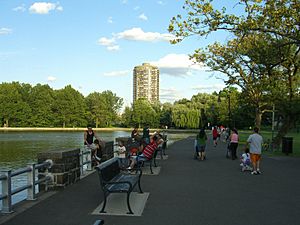
A very tall TV tower, the WOR TV Tower, was built in North Bergen in 1949. It was one of the tallest structures in the world at the time! Later, in 1967, the 34-story Stonehenge apartment building was built on the Palisades.
In the 1960s, scientists found interesting fossils from ancient times near the cliffs. These finds helped us learn more about the Earth's history.
North Hudson Park was renamed James J. Braddock North Hudson County Park after a local hero, James J. Braddock. He was a heavyweight boxing champion who lived in North Bergen and won his title in a huge upset in 1935.
North Bergen's population grew a lot in the second half of the 20th century. Many Spanish-speaking people, especially from Cuba, moved here starting in the 1960s. This led to the area being nicknamed "Havana on the Hudson."
Geography and Unique Features
North Bergen has a unique shape, often described as an inverted "L" or "axe-shaped." It borders several other towns and the Hudson River, which separates it from Manhattan, New York City.
The town has diverse natural features. The Hudson Palisades are tall cliffs that rise from the waterfront. The northern part of North Bergen sits on top of this high plateau. The western side of the town has a steep slope, making North Bergen one of the hilliest cities in the U.S., second only to San Francisco. Some of these hills are very steep!
There's even a special rock formation made of unusual serpentinite rock, which is one of the few undeveloped parts of North Bergen. The low-lying areas on the west side are part of the New Jersey Meadowlands, which include wetlands.
North Bergen has many different neighborhoods because of its unique shape and hills:
- Bergenline Avenue: A long street with over 300 shops and restaurants.
- Racetrack: An area on the plateau.
- Bergenwood: Located on the steep western slopes of the Palisades.
- New Durham: An older area with historical connections.
- Meadowview: Behind the Municipal Building, near the cemeteries.
- Bulls Ferry: On the Hudson waterfront, with a medical center and a walkway along the river.
- Babbitt: In the Meadowlands area, which includes a wetlands preserve.
- Woodcliff: On the Palisades, around North Hudson Park.
- Transfer Station: Near the border with Union City and Jersey City.
North Bergen has seven cemeteries, more than any other town in Hudson County. This might be because it had more open land than its neighbors in the past.
Population and People
| Historical population | |||
|---|---|---|---|
| Census | Pop. | %± | |
| 1850 | 3,578 | * | — |
| 1860 | 6,335 | * | 77.1% |
| 1870 | 3,032 | * | −52.1% |
| 1880 | 4,268 | 40.8% | |
| 1890 | 5,715 | 33.9% | |
| 1900 | 9,213 | * | 61.2% |
| 1910 | 15,662 | 70.0% | |
| 1920 | 23,344 | 49.0% | |
| 1930 | 40,714 | 74.4% | |
| 1940 | 39,714 | −2.5% | |
| 1950 | 41,560 | 4.6% | |
| 1960 | 42,387 | 2.0% | |
| 1970 | 47,751 | 12.7% | |
| 1980 | 47,019 | −1.5% | |
| 1990 | 48,414 | 3.0% | |
| 2000 | 58,092 | 20.0% | |
| 2010 | 60,773 | 4.6% | |
| 2020 | 63,361 | 4.3% | |
| 2023 (est.) | 59,394 | −2.3% | |
| Population sources: 1850–1920 1850–1870 1850 1870 1880–1890 1890–1910 1910–1930 1940–2000 2000 2010 2020 * = Lost territory in previous decade. |
|||
In 2020, North Bergen had a population of 63,361 people. This was an increase from 60,773 people in 2010. The town has grown quite a bit over the years.
Many different groups of people live in North Bergen. In 2020, about 70.86% of the population identified as Hispanic or Latino. This shows the strong influence of Spanish-speaking cultures in the community.
Economy and Jobs
North Bergen has several areas for shopping and businesses, especially along Bergenline Avenue and Tonnelle Avenue. Part of the town is an Urban Enterprise Zone (UEZ). This program helps encourage businesses to open and create jobs by offering benefits like a reduced sales tax rate. Shoppers in these zones pay half the usual state sales tax.
Some large companies that employ many people in North Bergen include Hudson News and Liz Claiborne. The New York, Susquehanna and Western Railway also has several freight facilities here.
Education for Students
The North Bergen School District provides education for students from kindergarten all the way through twelfth grade. In the 2018–19 school year, the district had about 7,576 students across seven schools.
The schools in the district include:
- Franklin School (grades 1–8)
- Robert Fulton School (grades K–8)
- John F. Kennedy School (grades 1–8)
- Lincoln School (grades Pre-K–8)
- Horace Mann School (grades 1–8)
- McKinley School (grades K–8)
- North Bergen High School (grades 9–12)
Students from nearby Guttenberg also attend North Bergen High School as part of a special agreement between the school districts.
North Bergen used to be home to High Tech High School, a special county school for grades 9-12. However, a new High Tech High School campus was built in Secaucus and opened in 2018. The old High Tech High School building in North Bergen was taken over by the North Bergen district, which plans to build a new junior high school there.
There is also a private preschool called A Step Ahead Preschool.
Getting Around North Bergen
Roads and Highways
North Bergen has many miles of roads. Some major roads that go through the township include Route 495, which connects the Lincoln Tunnel to the New Jersey Turnpike (Interstate 95). U.S. Route 1/9 runs along the western side of the town. Other important county roads like Kennedy Boulevard and River Road also pass through.
Public Transportation Options
Getting around North Bergen is easy with public transportation, including buses and light rail.
The Hudson-Bergen Light Rail (HBLR) has stations at Tonnelle Avenue station and Bergenline Avenue station (which is in Union City but close by). This light rail can take you to places like Weehawken, Hoboken, Jersey City, and Bayonne.
Bus service is very common along busy streets like Kennedy Boulevard, Bergenline Avenue, and Boulevard East. NJ Transit buses and private "dollar vans" (minibuses) travel within Hudson County and to Bergen County and Manhattan, New York City. Nungessers is a big spot where many bus lines start or transfer.
Many bus lines go to the Port Authority Bus Terminal in Midtown Manhattan. Other lines go to the George Washington Bridge Bus Terminal in Upper Manhattan or to places like Journal Square or Hoboken Terminal.
"Jitney" commuter buses (dollar vans) are very frequent along Bergenline Avenue, sometimes appearing every minute! They offer quick rides to places like the Port Authority Bus Terminal and shopping centers.
Media and Local Culture
North Bergen is part of the New York media market, so you can find most major newspapers here. There are also local papers like The Jersey Journal and Hudson Dispatch Weekly. The North Bergen Reporter is a free weekly paper that covers local news. You can also find news online at sites like HudsonCountyView.com and HudPost.com.
In recent years, North Bergen and nearby towns like Weehawken and Union City have become known as "NoHu." This area is a popular spot for artists, especially those from Latin America, because housing costs are lower than in bigger cities like Hoboken or Manhattan.
Famous People from North Bergen
Many interesting people have lived in or are connected to North Bergen:
- 070 Shake (born 1997), a rapper.
- Carlos Alomar (born 1951), a musician and songwriter.
- Kyle Anderson (born 1993), an NBA basketball player.
- Coco Austin (born 1979), an actress and model.
- Lidia Bastianich (born 1947), a famous chef and TV host.
- Odell Beckham Jr. (born 1992), a wide receiver for the New York Giants.
- James J. Braddock (1905–1974), a heavyweight boxing champion.
- John O. Brennan (born 1955), who worked in the Obama White House.
- James L. Brooks (born 1940), a director for TV and movies.
- Richard Castellano (1933–1988), an American actor.
- Gene Cornish (born 1944), a guitarist from the band The Rascals.
- Leo Cullum (1942–2010), a cartoonist for The New Yorker.
- Paquito D'Rivera (born 1948), a musician and composer.
- Joey Diaz (born 1963), a stand-up comedian and actor.
- Louis Freeh (born 1950), a former director of the FBI.
- Melissa Fumero (born 1982), an actress known for Brooklyn Nine-Nine.
- Ice-T (born 1958), a rap music pioneer and actor.
- AJ Lee (born 1987), a professional wrestler.
- Luigi Lucioni (1900–1988), a famous painter.
- Steve Mocco (born 1981), an Olympic wrestler.
- Ed Murawinski (born 1951), a cartoonist for the Daily News.
- Nicholas Sacco (born 1946), a politician and Mayor of North Bergen.
- John Scarne (1903–1985), an expert on gambling and magic tricks.
- Rena Sofer (born 1968), an actress.
- Wilbur Ross (born 1937), an investor.
- Yordenis Ugás (born 1986), an amateur boxer.
Images for kids
See also
 In Spanish: North Bergen para niños
In Spanish: North Bergen para niños


